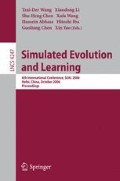Abstract
This paper introduces a computational model simulating the dynamic process of human immune response for solving Traveling Salesman Problems (TSPs). The new model is a quaternion (G, I, R, Al), where G denotes exterior stimulus or antigen, I denotes the set of valid antibodies, R denotes the set of reaction rules describing the interactions between antibodies, and Al denotes the dynamic algorithm describing how the reaction rules are applied to antibody population. The set of immunodominance rules, the set of clonal selection rules, and a dynamic algorithm TSP-PAISA are designed. The immunodominance rules construct an immunodominance set based on the prior knowledge of the problem. The antibodies can gain the immunodominance from the set. The clonal selection rules strengthen these superior antibodies. The experiments indicate that TSP-PAISA is efficient in solving TSPs and outperforms a known TSP algorithm, the evolved integrated self-organizing map.
Access this chapter
Tax calculation will be finalised at checkout
Purchases are for personal use only
Preview
Unable to display preview. Download preview PDF.
References
Jin, H.D., Leung, K.S., Wong, M.L., Xu, Z.B.: An Efficient Self-Organizing Map Designed by Genetic Algorithms for the Traveling Salesman Problem. IEEE Transactions on Systems, Man, and Cybernetics-Part B 33(6), 877–888 (2003)
Durbin, R., Willshaw, D.: An analogue approach to the traveling salesman problem. Nature 326, 689–691 (1987)
Reinelt, G.: The Traveling Salesman: Computational Solutions for TSP Applications. Springer, Heidelberg (1994)
Garrett, S.M.: How Do We Evaluate Artificial Immune Systems. Evolutionary Computation 13(2), 145–178 (2005)
Gong, M.G., Jiao, L.C., Liu, F., Du, H.F.: The Quaternion Model of Artificial Immune Response. In: Jacob, C., Pilat, M.L., Bentley, P.J., Timmis, J.I. (eds.) ICARIS 2005. LNCS, vol. 3627, pp. 207–219. Springer, Heidelberg (2005)
Gong, M.G., Du, H.F., Jiao, L.C.: Optimal approximation of linear systems by artificial immune response. Science in China: Series F Information Sciences 49(1), 63–79 (2006)
Yewdell, J.W., Bennink, J.R.: Immunodominance in major histocompatibility complex class I-restricted T lymphocyte responses. Annual Review of Immunology 17, 51–88 (1999)
Burnet, F.M.: The Clonal Selection Theory of Acquired Immunity. Cambridge University Press, Cambridge (1959)
Burnet, F.M.: Clonal selection and after. Theoretical Immunology, pp. 63–85. Marcel Dekker, New York (1978)
Garrett, S.M.: Parameter-free, Adaptive Clonal Selection. In: The Proceedings of IEEE Congress on Evolutionary Computing (CEC 2004), Portland Oregon, June 2004, pp. 1052–1058 (2004)
de Castro, L.N., Von Zuben, F.J.: Learning and Optimization Using the Clonal Selection Principle. IEEE Transactions on Evolutionary Computation 6(3), 239–251 (2002)
Reinelt, G.: TSPLIB—A traveling salesman problem library. ORSA Journal of Computing 3(4), 376–384 (1991)
Author information
Authors and Affiliations
Editor information
Editors and Affiliations
Rights and permissions
Copyright information
© 2006 Springer-Verlag Berlin Heidelberg
About this paper
Cite this paper
Gong, M., Jiao, L., Zhang, L. (2006). Solving Traveling Salesman Problems by Artificial Immune Response. In: Wang, TD., et al. Simulated Evolution and Learning. SEAL 2006. Lecture Notes in Computer Science, vol 4247. Springer, Berlin, Heidelberg. https://doi.org/10.1007/11903697_9
Download citation
DOI: https://doi.org/10.1007/11903697_9
Publisher Name: Springer, Berlin, Heidelberg
Print ISBN: 978-3-540-47331-2
Online ISBN: 978-3-540-47332-9
eBook Packages: Computer ScienceComputer Science (R0)

